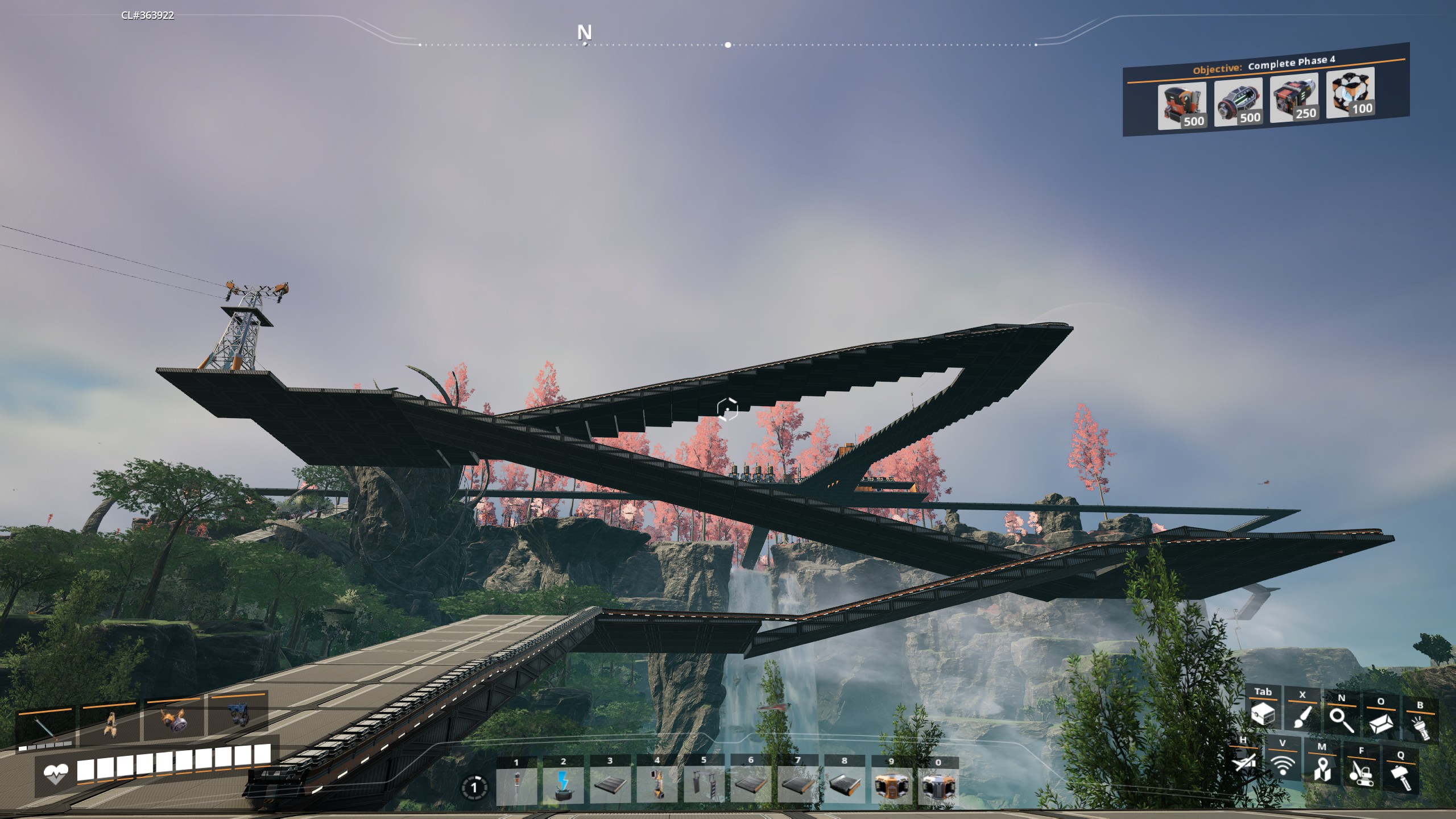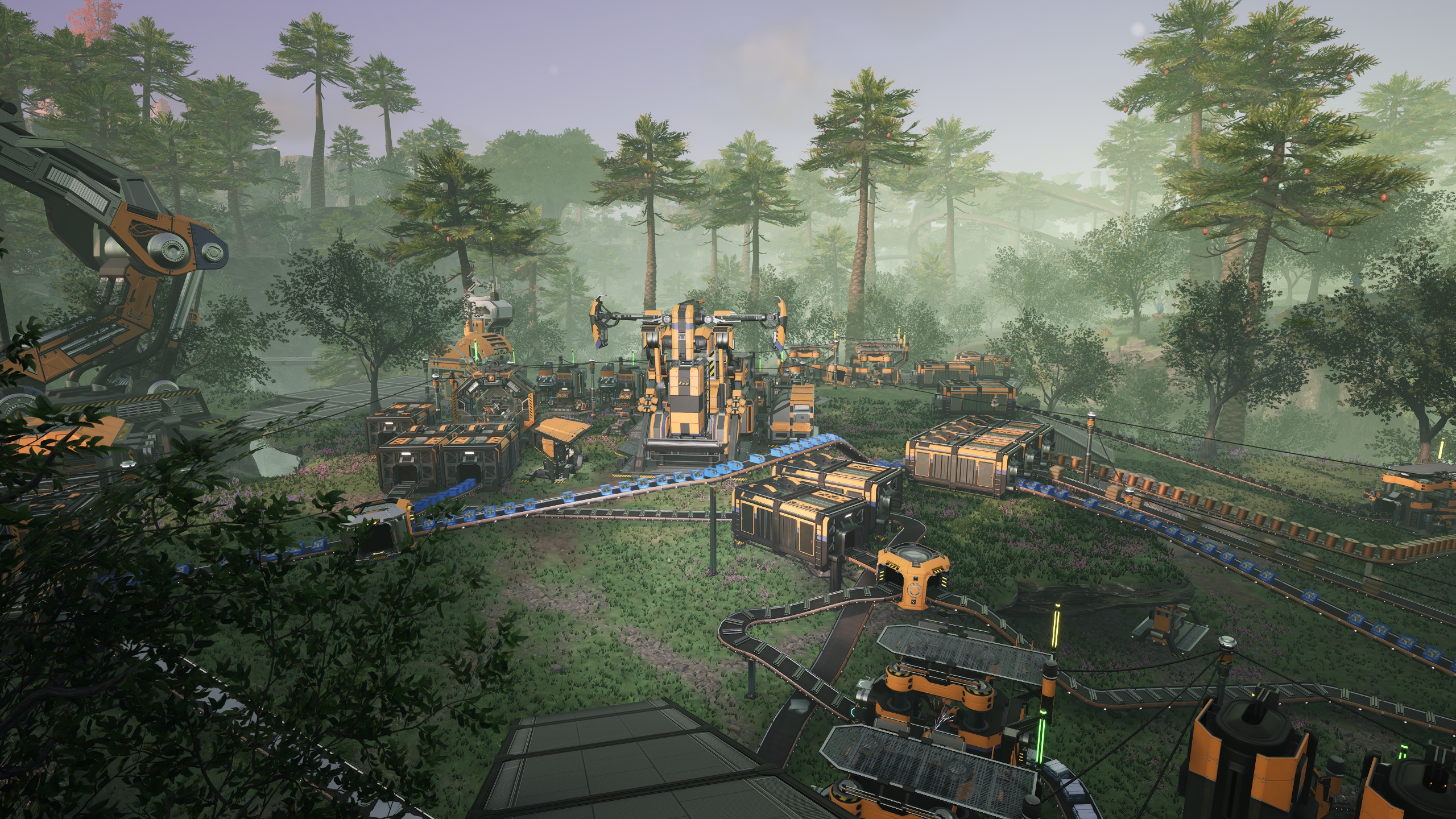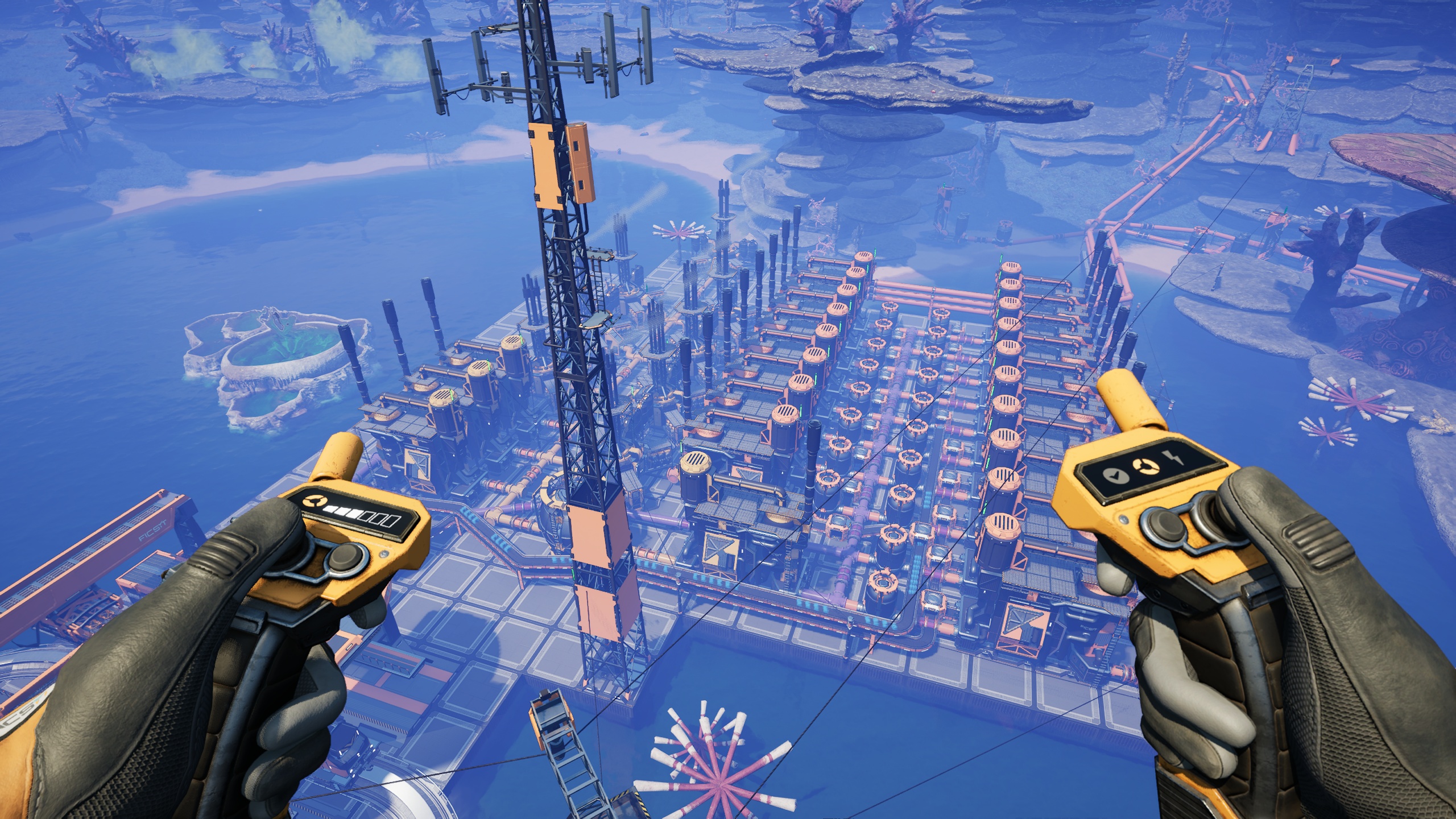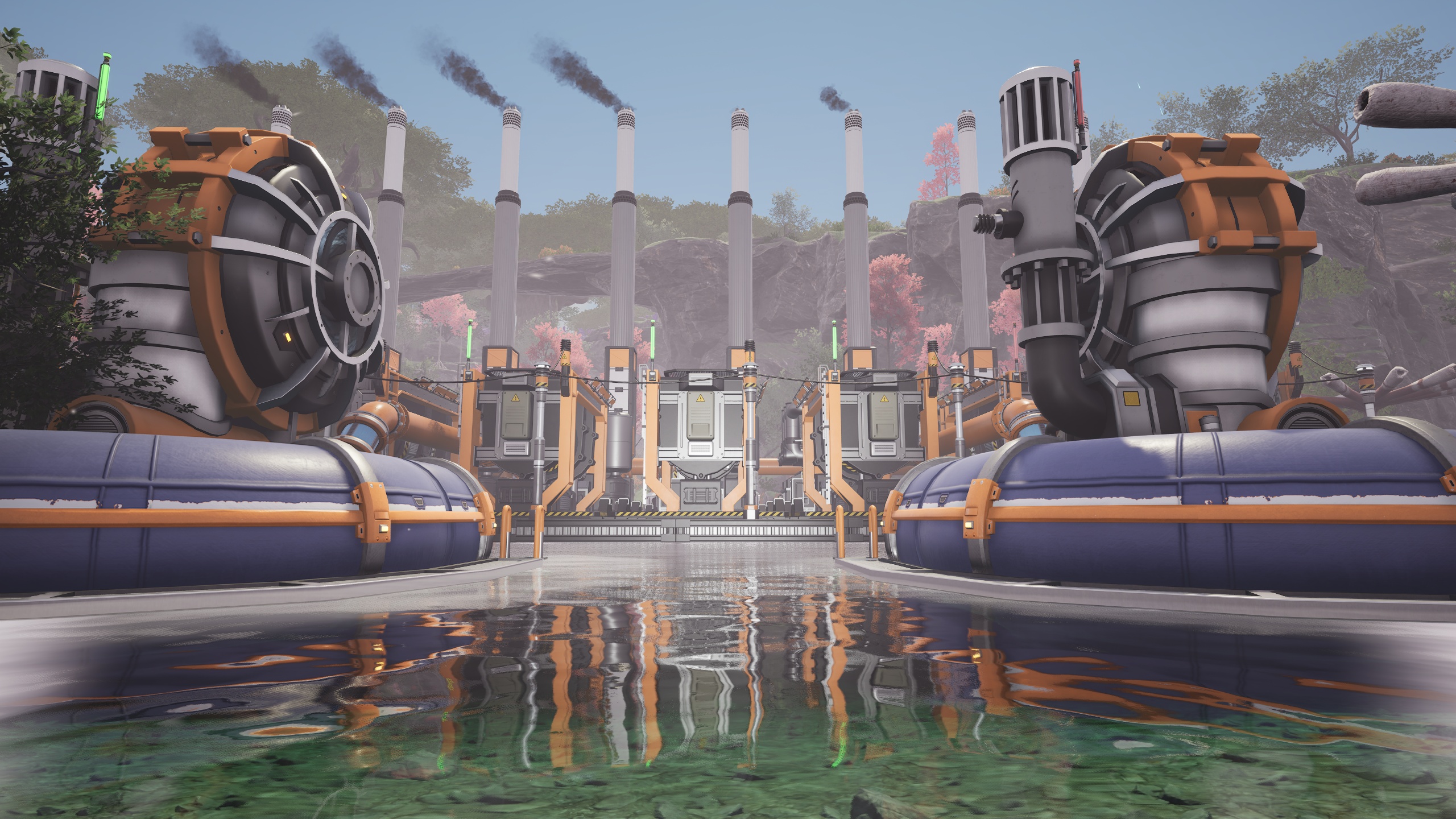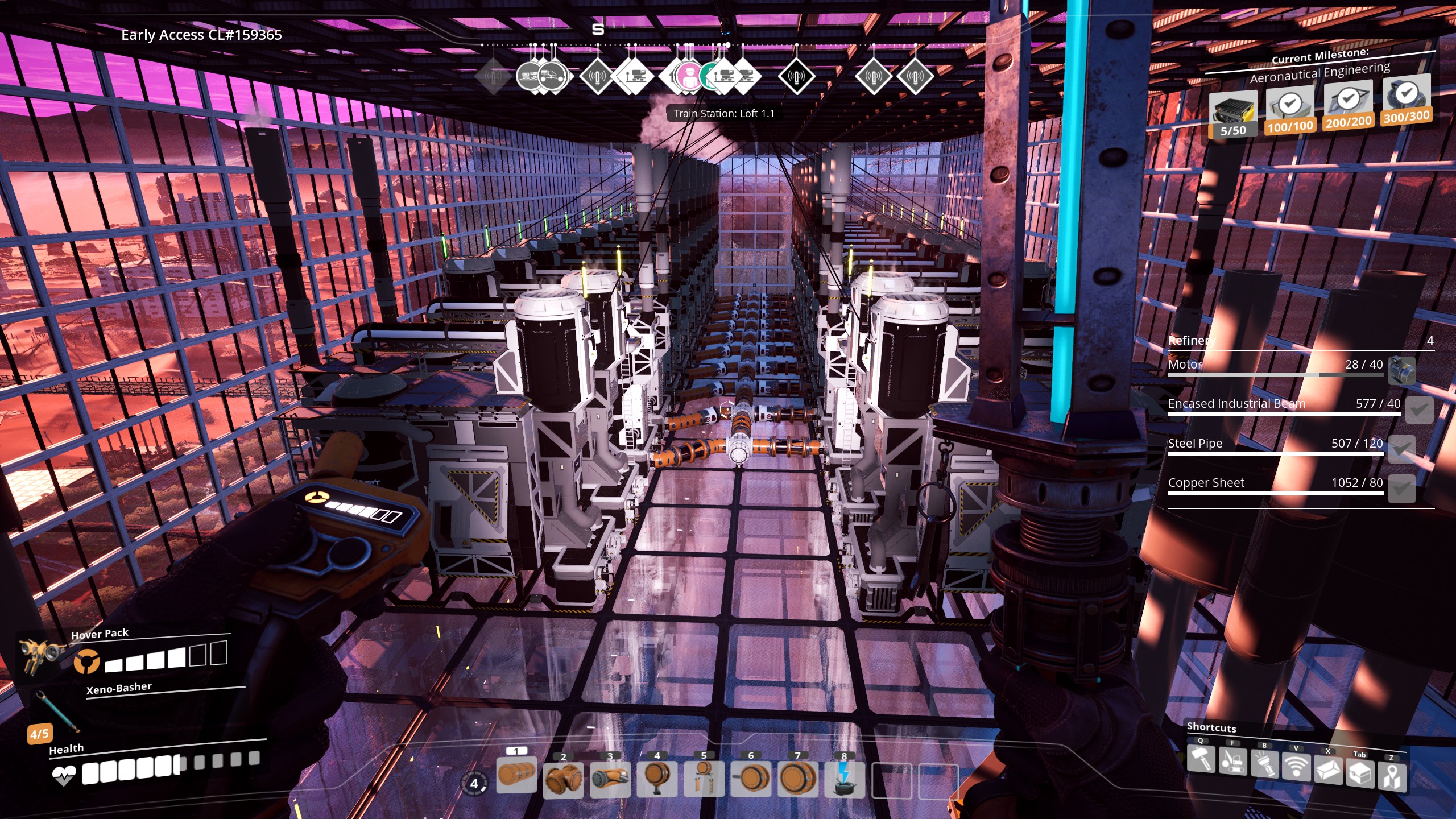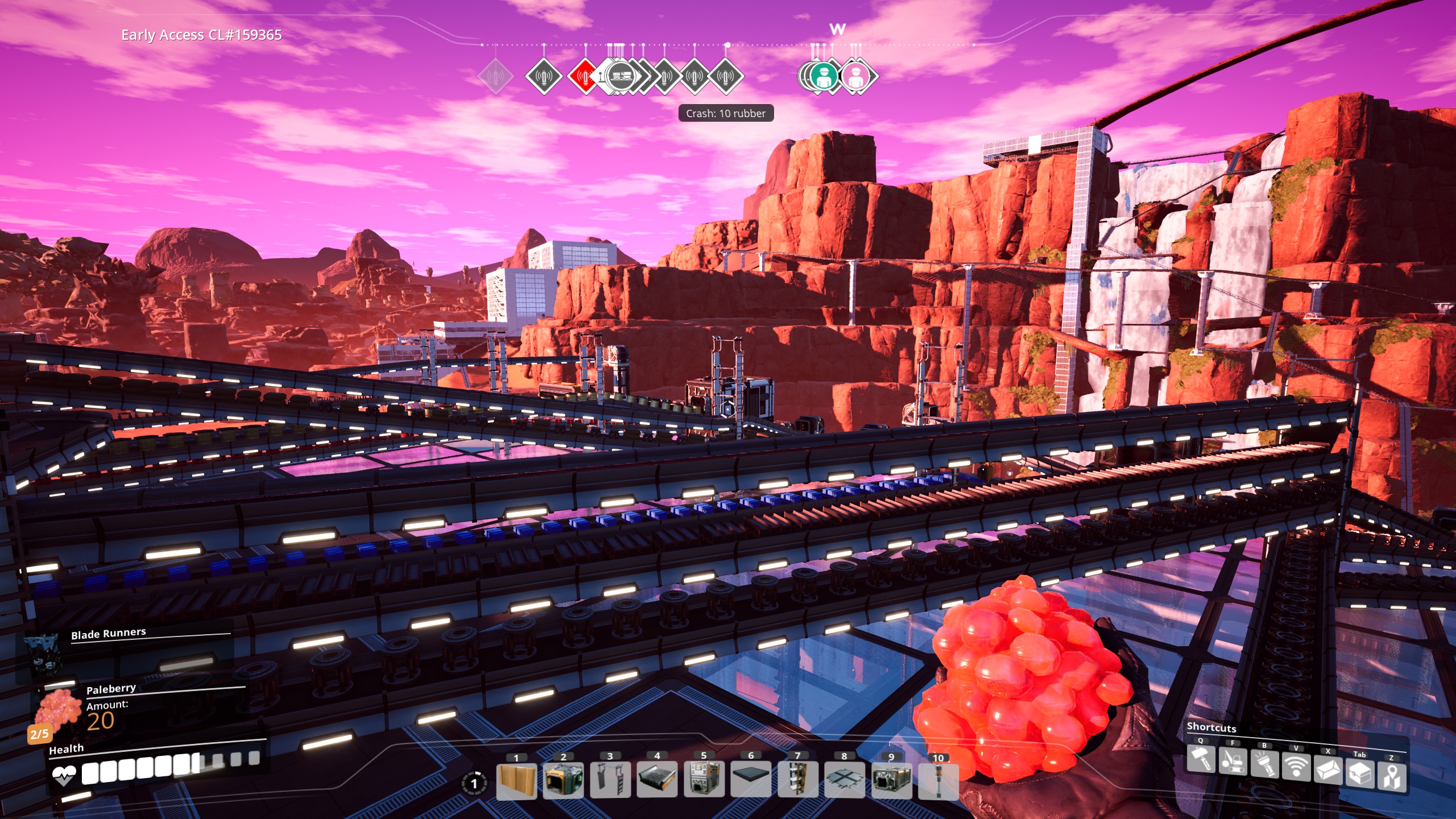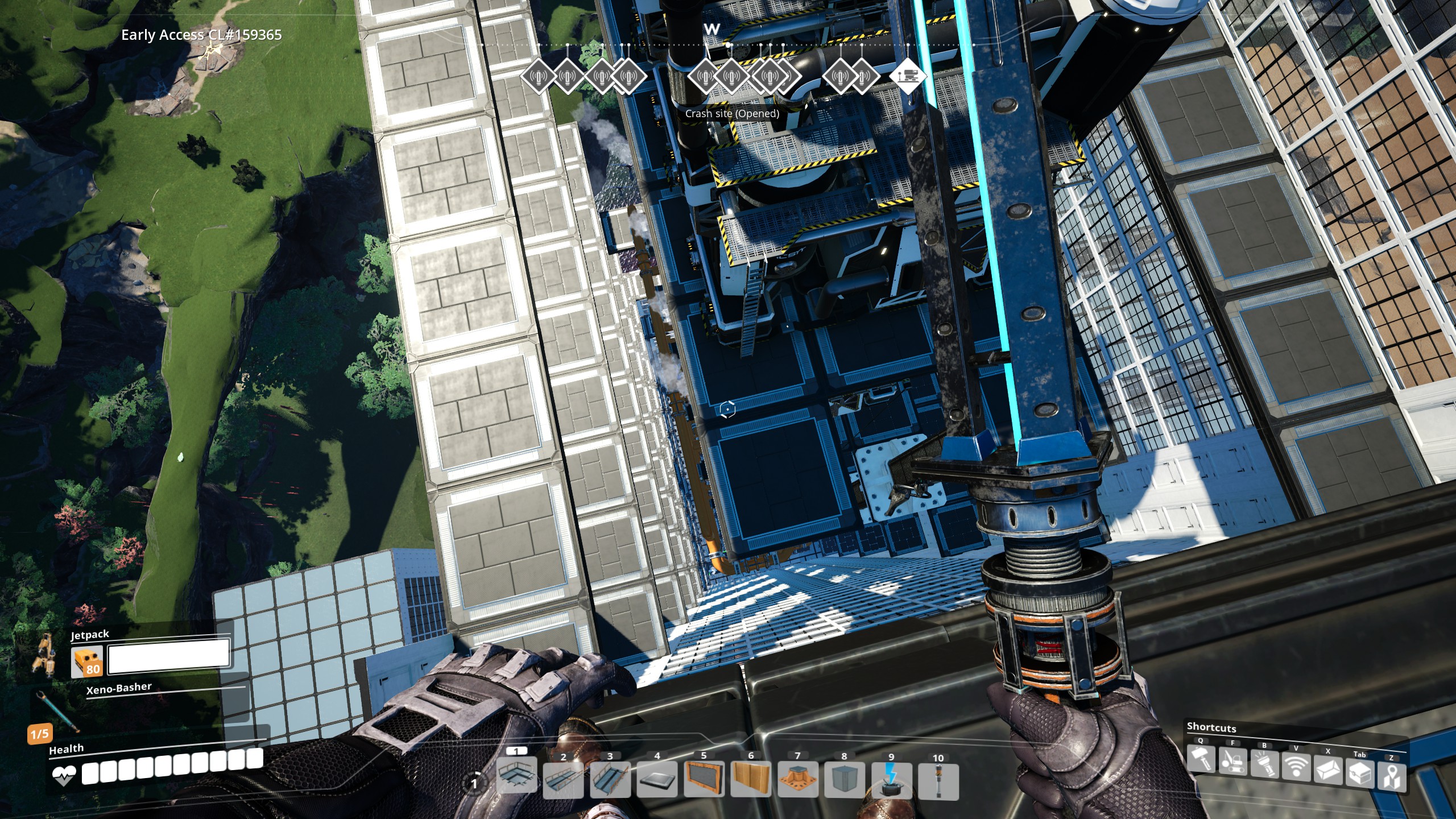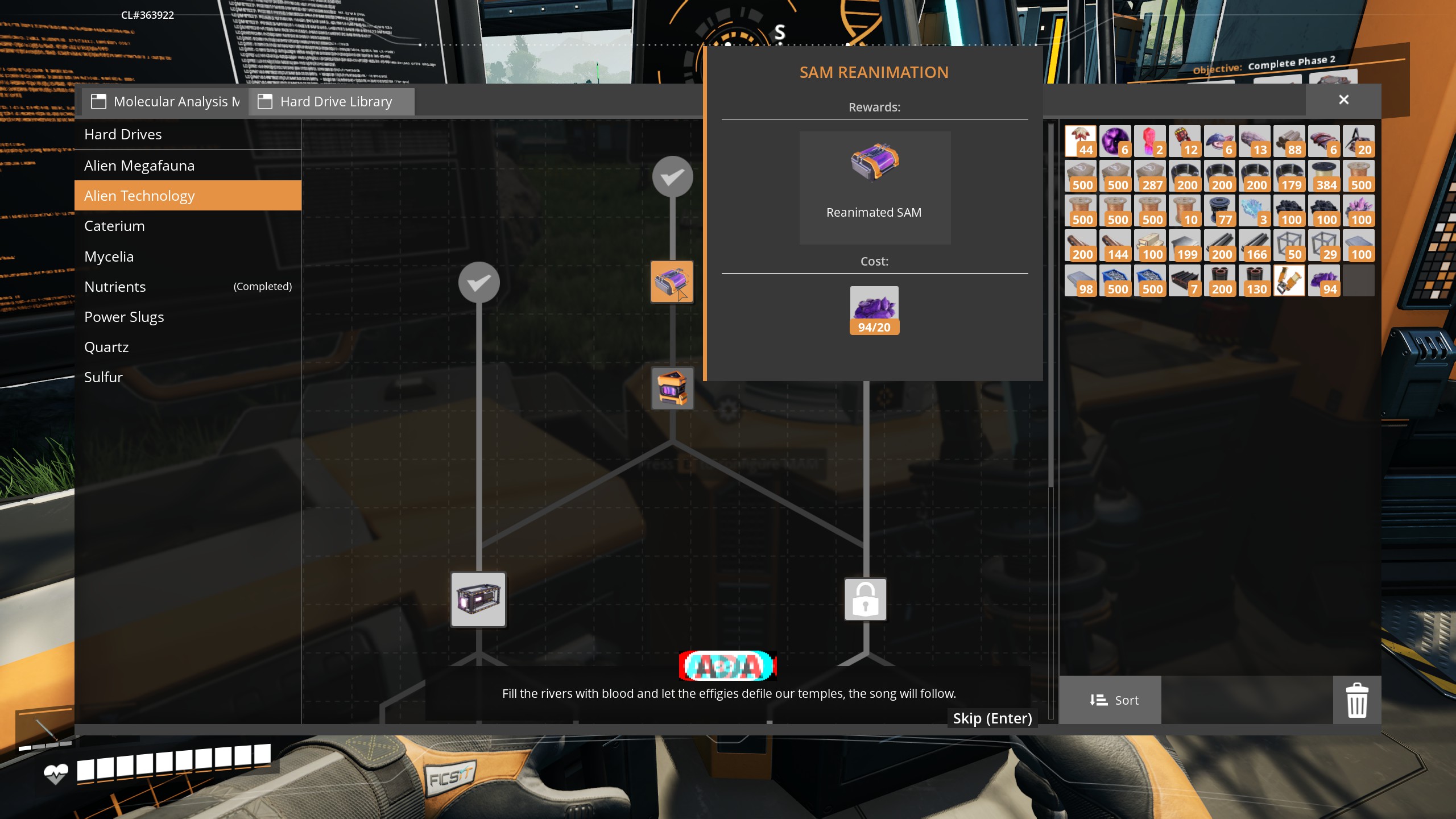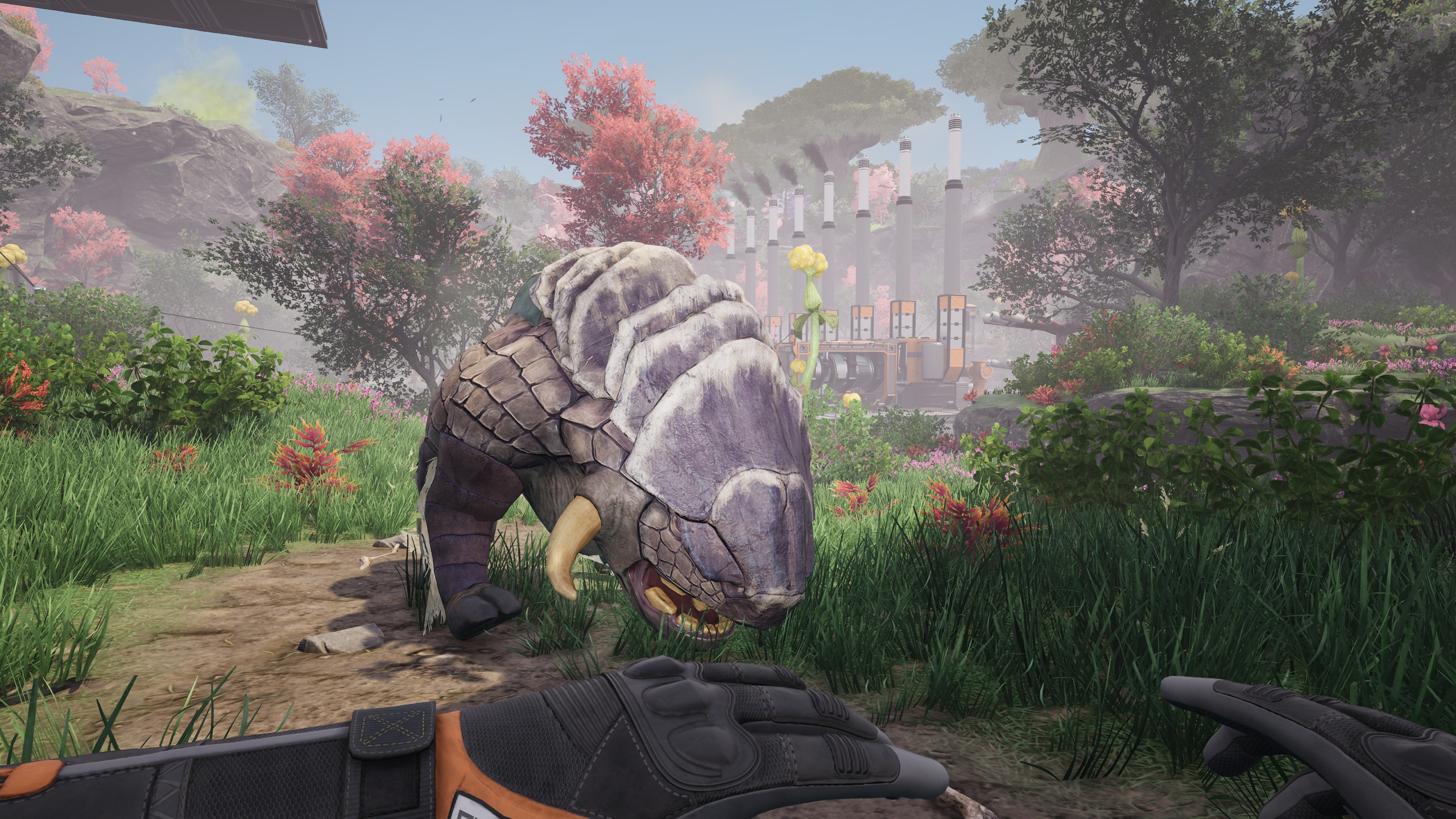I’m knee deep in a swamp doing math for aluminum production: three miners pulling ore means I’ll need six pumps for water, so that I’m pushing out about 420 cubic meters of alumina solution per minute, and I figure a holding tank here as a buffer would be good, so I slap one down and climb up on top of it. That takes me above the treeline, and suddenly I realize the sheer scale of what I’ve organized and built in the last 50-some hours.
Need to know
What is it? A factory building survival-craft adventure
Expect to pay $40
Developer Coffee Stain Studios
Publisher Coffee Stain Publishing
Reviewed on
Steam Deck: Playable
Multiplayer? 4-player co-op (or more, on dedicated severs)
Link: Official site
I can see the towering field of nuclear reactor cooling towers about two kilometers off pumping up gentle white clouds. Past that there’s the much smaller cliffside facility, tiny at this distance, that I set up 20 hours ago as my first aluminum plant. And above it all I can see the top of my main factory complex, peeking over a jungle-covered ridge some four or five kilometers away. Barely visible, but I know it’s sitting in the middle of a field that takes several minutes to cross on foot. At the center of it all I see the massive space elevator, its cable visible from every corner of the map stretching upward to the megaproject in the heavens.
It’s an exhilarating feeling knowing you planned, built, and executed all of that construction. True to its name, this is a factory-building game that’s simply satisfying.
Dumped onto an unexplored alien world, your job as a pioneer for FICSIT, Inc is to use advanced technology to build up an industrial base capable of sending various parts skyward to complete the mysterious Project Assembly. Your work is all overseen by detached artificial intelligence ADA—who says it’s for the survival of the human race, but seems more interested in mysterious alien artifacts than saving lives.
Satisfactory takes the basic trappings and open world setting of first-person survival genre and blends it with the flow of factory building and automation. You will always need a few hundred or a few thousand of some finished product—metal sheets, rotors, engines, computers, quantum crystals, whatever—and you’ll need to build and connect chains of resource gathering, processing, and finishing machines to get there. To build those you’ll first need to scout out the terrain, evading or battling hostile wildlife for those resources and the optimal space to place those machines.
A simple setup might take ore from a deep-bore miner, move it to an array of smelters via conveyor, then take the resulting metal ingots into constructors that stamp them into panels and rods and screws before connecting those parts into a framework in a larger assembler. Set up a half-dozen of those machines and you’ll quickly have a few hundred frames to send for study—via your handy orbital drone—to unlock a new tier of technology.
Comparatively larger goals, like for your main objective Project Assembly, require a few thousand of much more complex parts sourced from several different ores and a half-dozen different machines in different orders. Those get fed into the massive early-game goal: A giant space elevator. The luxurious animation for this thing has one of my all-time favorite non-cinematic sequences in a game, as a massive tether comes falling down out of the sky to hook into the elevator base you’ve built.
A game about undertaking these kinds of megaprojects means building a lot, and scaling it up, and up, and up. One thing Satisfactory understands is scale. Your first few machines are boxy, the size of a small car or mid-size truck, but by the third and fourth tiers of unlocked technology you’re placing townhouse-sized coal power plants, refineries with towering smokestacks the size of an apartment building, and train stations the size of an aircraft hangar. And you’re doing it by the dozens! A reasonable mid to late game oilfield will have something like 60 refineries setup and running to make plastic, rubber, fuel oil, and more. Each of them the size of a townhome, connected by a maze of pipes and conveyors. To make room for mine and the train infrastructure that served it I simply paved over most of a lake biome the game calls Blue Crater with concrete-and-steel foundation squares.
For all that scale, Satisfactory doesn’t neglect detail. One of my favorite bits, the mining machines, are all set up so that they drill ever-deeper. A lesser game might just let that drill sink into the ground in the initial animation and never think of it again. Not Satisfactory, though, which makes sure that all the miners have an elaborate animation adding new segments to the drill shaft every so often.
Actually building factories is done in first person by placing blueprints that you can either drop freehand or snap onto a grid of foundations that you’ve built. That means setting up and placing kilometer after kilometer of at first conveyor belts, then truck roadways, then train tracks, even a network of flying delivery drones. But always the conveyor belts, to be clear. Everything you build will want to be connected, manually, to your growing spiderweb of part-moving sprawl at the correct ratios and speeds. It’s what you spend a lot of time doing.
The strongest critique of Satisfactory I have is that at times this means you do things that are pretty tedious. Most of that time is going to be connecting a swathe of new buildings to your factory, looking from each one to a pole to attach power lines, clicking the in and out ports for conveyors, then attaching those conveyors to mergers so that all the products come out in one line. It is, simply put, time-consuming and dull compared to the simple click and drag that other factory games can manage from their isometric or top-down perspectives. You can make your own blueprints, which are sets of pre-made buildings to use, but there’s no way to build a full setup that will start and end with connected, working conveyors. You’re always going to connect things yourself.
Satisfactory is a long game for just that reason. It’s packed with things to do, sure, but some of that stuff is going to be repetitive, a product of the survival craft genre DNA that suffuses it. This is the one part of the game that can drag, and to compensate I’d recommend playing this thing in co-op with friends. It works great, in my experience, and each new player adds more than double the efficiency to the team—except for that one person who just spends all their time making the factory buildings look pretty.
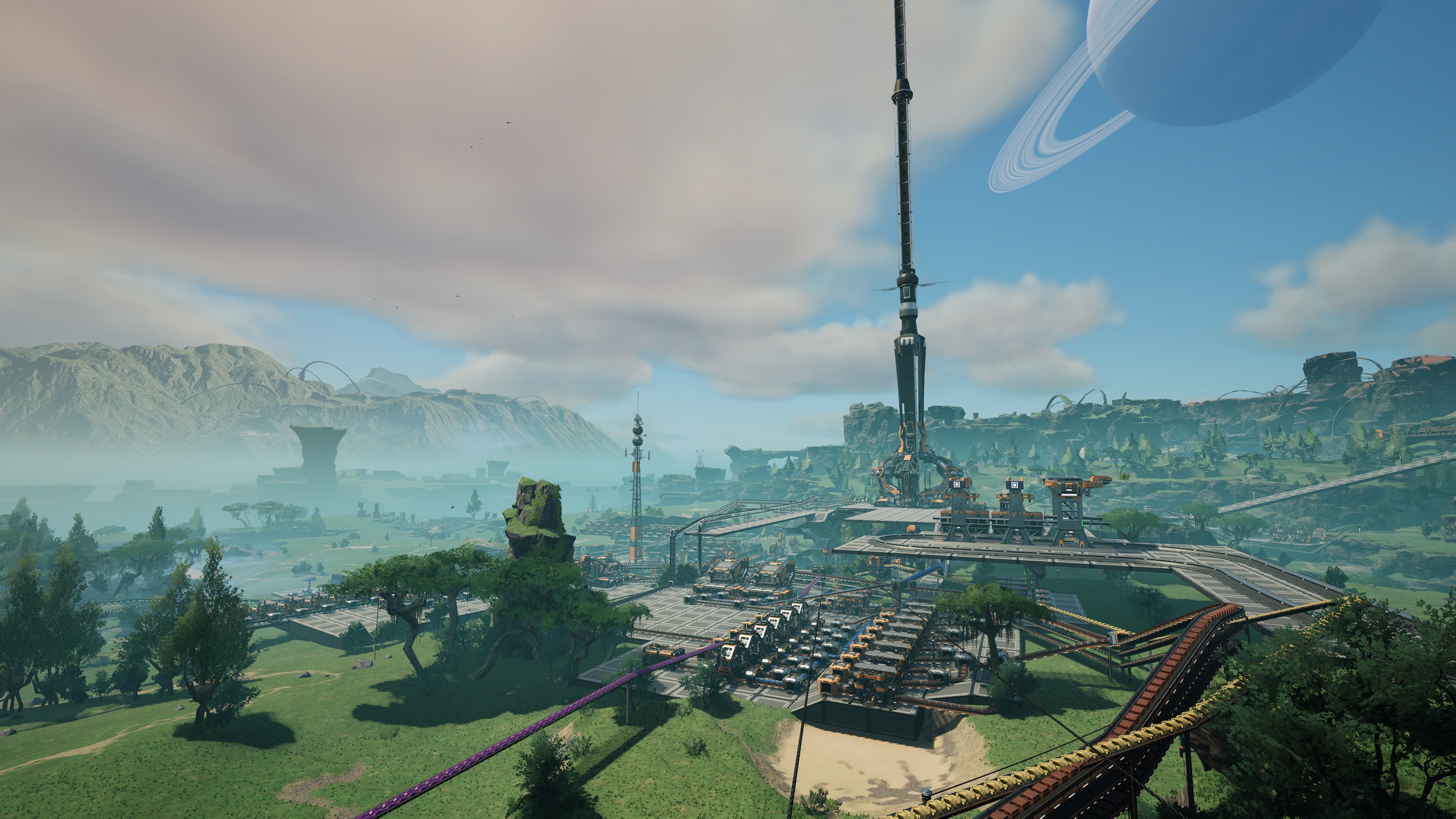
Which is totally something you can do. Maybe even more than it’s about automation, Satisfactory is about the process of building up all this stuff and enjoying yourself as you do it. While other factory games can become detached from creation as you plop down yet another iteration of your best blueprint, Satisfactory’s emphasis on building in a three-dimensional space means that you instead adapt your design to the constraints of where you’re building it. If I didn’t have that big open lake to build my refinery on, for example, it might have made more sense to pump all my oil into tanker cars and haul it somewhere easier to build. Satisfactory isn’t just in 3D for kicks, but because the space means you’re dealing with interesting design choices in how you lay out your buildings and move around the world. All of its tools and automation challenges are designed with those considerations thought through and reasoned to their conclusions.
The side effect of how much it emphasizes the joy of building big stuff is that there’s a ton of parts to unlock and use for decoration, embellishment, and generally making your factories fancy as Versailles. Factory Versailles. There are parts from basic foundation blocks to doors, windows, viewports, glass walls, roofs, pillars, walkways, ladders, stairs, ramps, signs, markings, fences—all of which are customizable with both textures and a huge palette of colors and designs to tweak.
Enjoying how good everything in Satisfactory looks is a big part of this game. The planet of MASSAGE-2 (A-B)b is characterfully designed, with a varied ecosystem to explore and see and enjoy and occasionally be frightened by. There are some beautifully stunning vistas and every inch of the quite large (47 km2!) game map has clearly been made by someone on purpose. It puts the massive, yet bland, open worlds of some other survival games to shame both in size and variety and in the little handcrafted details you find while exploring.
Because in truth, making an efficient factory is only a part of this game, as is building and customizing it. The other big thing here is exploring the world you’re in to find stuff that’ll help you along the way. At its most basic this is finding new resources, at least four of which require you to stumble upon them in the wild before they’re introduced as something you can scan for mineable deposits of.
But you can find more exotic stuff out there—like glowing slugs that can be reduced into Power Shards to turbocharge your factory buildings, allowing you to scale up production without stressing over building more stuff. It’s as elegant a game design solution as I’ve ever seen: It turns exploring, which isn’t “productive” for the factory game loop, into something that directly benefits your already-built factory complex with minimal fuss.
There are also alien artifacts and remnants scattered in hidden places around the world, adding an element of the collectathon to your survival experience. These are strange, unsettling objects of alien geometry: artifacts like glowing void-eyed Mercer Spheres and Somersloops, a kind of crystalline ouroboros. Both of which, by the way, feed back into your factory-building experience by letting you unlock upgrades. Mercer Spheres for example, let you create an extradimensional reserve of parts so you’re never without the things you need to grow your factory—a blessing you’ll cherish when you don’t have to travel back across the map because you ran out of cabling mid-build.
Unlocking upgrades and finding alien stuff are where most of Satisfactory’s light storytelling comes in, narrated by ADA when you unlock upgrades and find artifacts. ADA’s light on relating what’s really going on, instead urging you to keep working more and better with a mix of faint praise, bad robot jokes, and unsubtle jabs. “FICSIT’s predictions indicate pioneers should generally reach this point faster with above-average results, but we should all adjust our expectations according to the situation,” they drone as you complete one project phase.
The story hinges around the disturbing implications of the alien technology you find, as well as your own mute, amnesiac protagonist’s relationship with the tongue-in-cheek dystopian capitalist FICSIT organization. It’s not winning narrative awards, but it’s also not overbearing. It’s a breezily entertaining sci-fi romp that smartly unfolds despite the unpredictable order of an open world game, and delivers some good goosebump-inducing phrases to boot. “Our bones are more beautiful than yours,” intones a glitchy alien voice at one point, apropos of nothing.
And what a sandbox it is! I cannot impress on you how fun it is to move around in this world, something I can’t say about almost any other automation game. Satisfactory understands the affordances that the first-person perspective gives: You start fairly slow, but can jump and do that FPS action movie slide underneath low objects or down slopes. Over time you get a pair of speed-and-jump-enhancing leg augments so you can execute all manner of what I like to call “factory parkour” over the tops of objects.
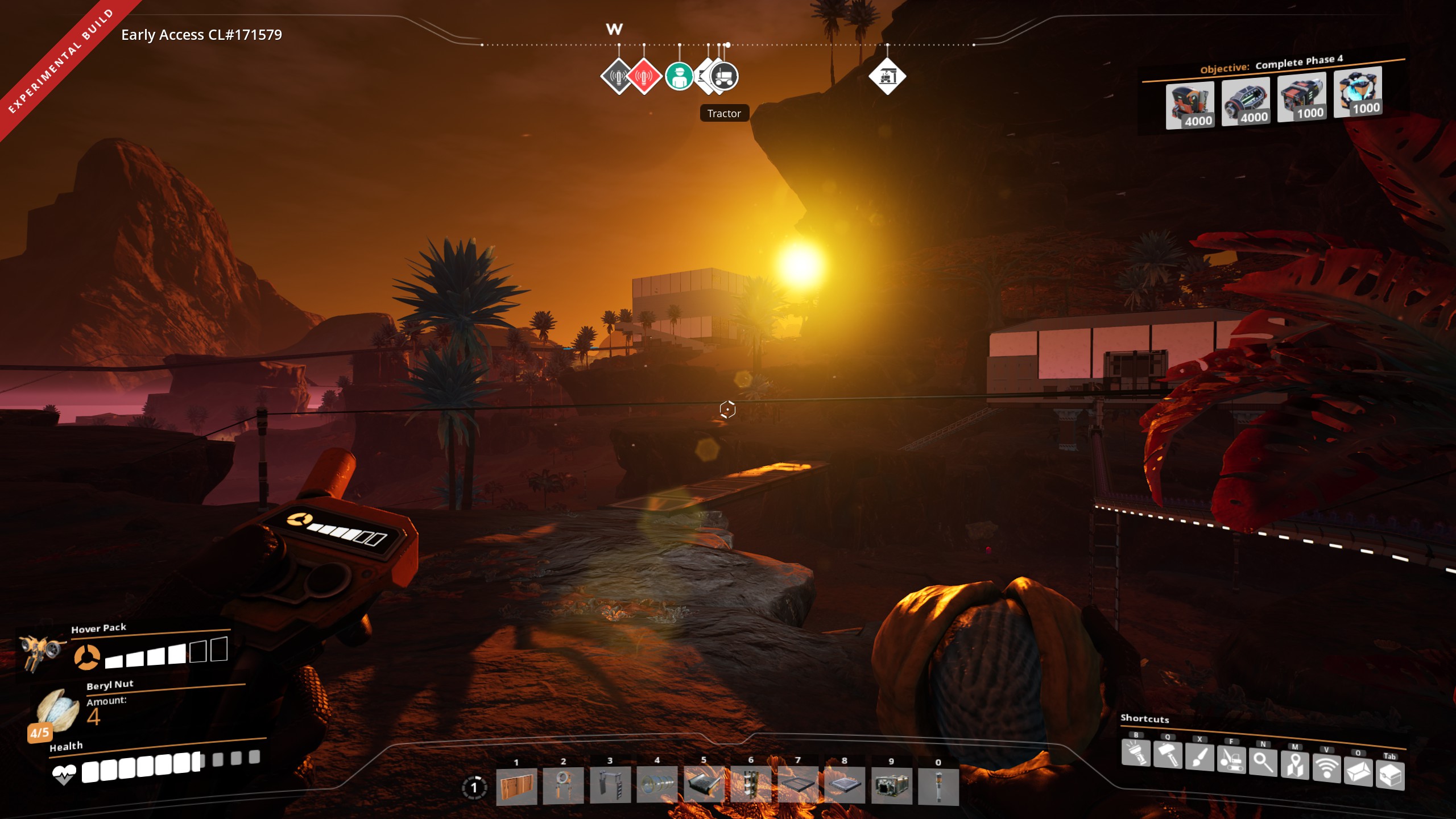
Then you get a brilliant “zipline” that lets you ride the overhead wires of your power grid. You get a jetpack, and later a hovering helicopter backpack. You get a chuntering little tractor and then a big thunderous truck and even a sporty little exploration buggy. You get a doofy little factory go-kart, complete with flashing safety lights. It’s “worse” than the other modes of transportation, which makes it the funniest to drive around.
Sci-fi story and trappings aside, Satisfactory never takes itself so seriously that it stops providing you with tools to play with and bend the rules—like mercifully letting buildings and conveyors clip into each other if you don’t mind the aesthetic sacrifice. For all that the factory-building genre is about balancing input and output rates with proper conveyor belt loads, Satisfactory remembers that videogames are also supposed to be satisfying and silly. It turns your building game into a theme park all its own, where you can turn this colorful alien landscape into a work of your imagination.


